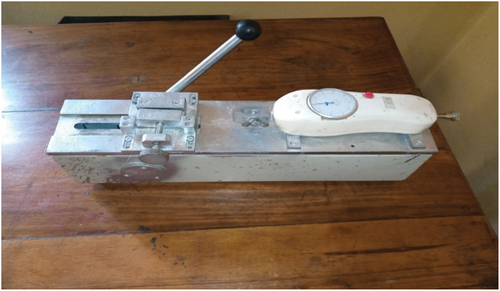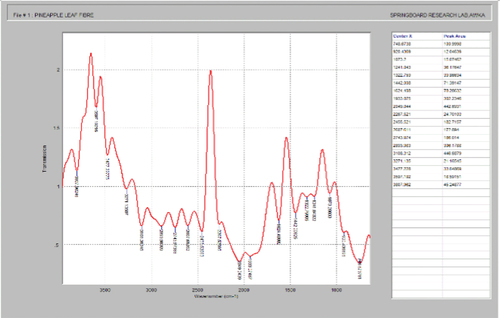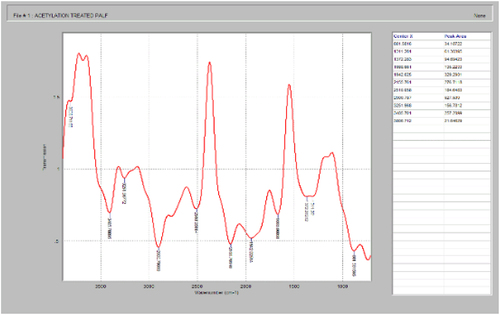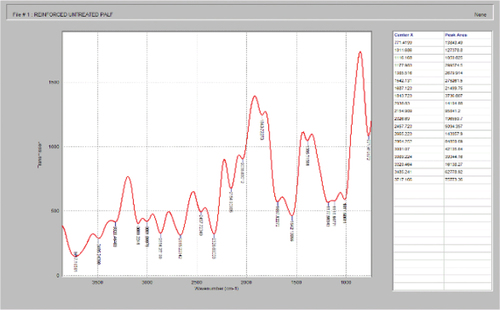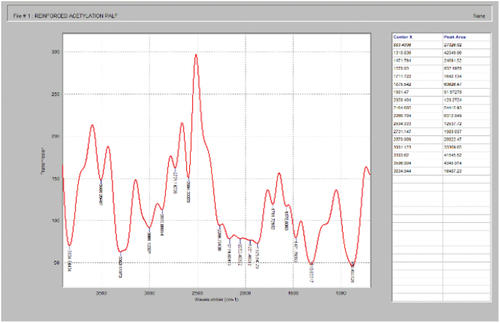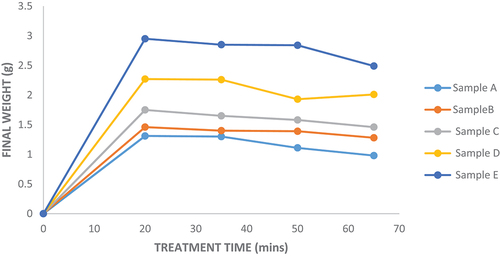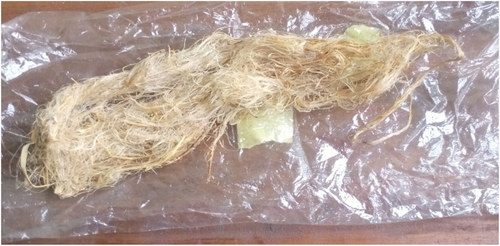Abstract
In this research, the effects of acetylation treatment on pineapple leaf fiber (Ananas comosus) reinforced with tapioca bio resin (cassava starch) were studied. The mechanical and chemical properties were examined using a yarn textile machine and an FTIR instrument. Alkali (NaOH), glacial acetic acid (CH3COOH) and acetic anhydride ((CH3CO)2O) were used for the treatment. After the treatment, an increase in the surface roughness of the fiber and a reduction in its hydrophobic nature were observed. A better mechanical locking property was also achieved due to the introduction of void on the fiber’s surface. FTIR spectroscopy indicated that there were slow but consistent changes that led to the removal of materials like oil, lignin, wax and pectin when the treatment time was increased. The results show various peaks in the absorbance versus wave number relation and the presence of O-H stretch, H-C-H bond, N-H stretch and N=O bond. The results from the tensile test proved that acetylation-treated pineapple fiber reinforced with cassava enhances the mechanical strength of the fiber when compared with untreated fiber.
1. Introduction
Using natural fibers as reinforcement in processing of plastic composites has drastically increased recently and has opened up further industrial possibilities (Kellar, Citation2003; Oksman et al., Citation2003; Rana et al., Citation2003; Singleton et al., Citation2003; Valadez-Gonzalez et al., Citation1999). Natural-fiber-reinforced composites form a new class of materials which seem to have good potential in the future as a substitute for wood-based material in many applications. The reinforcement of materials such as polyester with fibers from various lignocellulosic sources has been reported by numerous researchers (Atiqah et al., Citation2018; Atuanya et al., Citation2014; Baghban & Mahjoub, Citation2020; Hussain et al., Citation2016; Odera et al., Citation2015, Citation2016; Salem et al., Citation2020; Thakur & Thakur, Citation2014; Yan, Citation2012). Natural fiber has many advantages over synthetic fibers for composites, but its main disadvantage is the poor compatibility of fiber and hydrophobic matrix due to its high moisture absorption; hence, chemical treatments and surface modifications are done to improve its properties.
Reduction of OH- functional groups on the surfaces of fibers is achieved by chemical treatments subjected to natural fibers which modify the microstructure of the fibers, improve its surface chemistry and topography/its roughness and create a better interfacial interaction between fibers and their matrixes. As a result of this, better thermo-chemical properties are obtained due to enhanced wettability, surface morphology and fiber matrix compatibility (Alotaibi et al., Citation2019; Varghese & Mittal, Citation2017; Várdai et al., Citation2020; Wang et al., Citation2019; Athith et al., Citation2017; Debeli et al., Citation2018; Dolez et al., Citation2017; Halip et al., Citation2019; Mahjoub et al., Citation2014, Manimaram et al., 2018; Singh et al., Citation2017). Pineapple leaf fiber (PALF) is a multi-cellular natural hemp fiber extracted from the leaves of plant Ananas comosus of the Bromeliaceae family. It contains lignin, pectin, cellulose and hemi-cellulose. PALF has a ribbon-like structure and is cemented together with lignin and pentosan-like materials which contribute to the strength of the fiber. The unique mechanical properties of this fiber are its high cellulose content (75–82%), low density (1.5 g/cm3) and low micro-fibrillar angle (14°). PALF is used as reinforcements for composites because of its availability, encouraging agricultural-based economy, low cost and superior mechanical and physical properties than other natural fibers.
There is no reported study—to our knowledge—on the production of PALF reinforced with tapioca bio-based resin. Hence, the effects of acetylation treatment on PALF reinforced with tapioca bio-based resin were explored in this study. Acetylation treatment of natural fiber introduces acetyl group (CH3COO−) into the organic compound and causes plasticization of cellulosic fiber; hence, the fiber becomes hydrophobic with increased dimensional stability. Acetylation aids in reducing the susceptibility of natural fibers to absorption of moisture, thereby enhancing the dimensional stability and environmental degradation resistance of the reinforced fibers. Acetylation yield fiber composites with better results at all fiber loadings have been reported (Chukwudi et al., Citation2015). It has also been reported that acetylation leads to the formation of strong covalent bonds, thus showing an improvement in tensile strength and Young’s modulus of treated fiber (Sreekala & Thomas, Citation2003).
2. Methodology
2.1. Pineapple leaf fiber
PALF was obtained from pineapple leaves and was manually processed. The leaves were soaked in water for 24 hours, scraped with the aid of a broken plate to remove the waxy surface, and the fibers were scraped and cleaned. The fibers were sun-dried for 5 days and carefully kept for future use.
2.2. Tapioca bio resin (cassava starch)
Tapioca bio resin was prepared manually using fresh cassava tubers obtained from a farmland at Ihiagwa Owerri west, Imo State. Fresh cassava tubers were peeled, rasped (removal of the outer layers), cut into smaller pieces, soaked in water for days (5 days) and ground. The ground cassava tubers were sieved using a chiffon material to separate the starch from the chaff and kept in a bag to squeeze the water out from it.
2.3. Equipments
Equipments used in this study include water bath, beakers, gloves, nose mask, scissors, distilled water, paper tape, electronic weighing balance, spatula/stirrer, sample foil and yarn textile testing machine.
2.4. Chemicals (reagents) used
Glacial acetic acid (CH3COOH) and acetic anhydride acid ((CH3CO)2O) used for acetylation treatment of fibers were bought from Chemiscience Nigeria Limited, Owerri, Imo State, and were of analytical grade.
2.5. Characterization
2.5.1. Fourier transform infrared (FTIR) spectroscopy
Before and after the chemical treatment, the fibers were examined using FTIR. FTIR test was conducted using Perkin Elmer transmission method with KBr pellets. The wave number swept was from 3,500 to 1,000 cm−1.
2.6. Acetylation treatment
Acetylation treatment was carried out in Polymer and Textile Engineering Laboratory at Federal University of Technology Owerri (FUTO), Nigeria. The fibers were weighed for five different weights (1.4, 2.0, 2.5, 3.2 and 4.0) and were kept carefully for future use.
2.6.1. Alkali pretreatment
In this study, fibers were pretreated with alkali before acetylation treatment. After the alkali pretreatment, the fibers were washed with distilled water and dried for 48 hours. For alkali pretreatment, 2.0 g, 3.7 g, 4.5 g and 5.5 g of NaOH were dissolved in 500 ml of distilled water and treated at 30°C, 45°C, 60°C and 90°C, respectively, for 45, 60, 90 and 120 minutes, respectively, and the following weights of fibers were immersed in them: 1.4, 2.0, 2.5 and 4.0. The treatment was done using water bath.
2.6.2. Acetylation treatment
For acetylation treatment, 20 solutions were prepared using glacial acetate and acetic anhydride and were treated at varied temperatures.
2.7. Glacial acetic acid treatment
For this treatment, fibers with alkali pretreatment at 30°C, 45°C, 60°C and 90°C, respectively, were treated in 100 ml of glacial acetate acid for 20, 35, 50 and 65 minutes, respectively. All samples were treated at 30°C.
2.8. Acetic anhydride treatment
The samples from glacial acetate acid were transferred into 100 ml of acetic anhydride acid and treated at same temperature and varied time periods. Thereafter, the fibers were washed thoroughly with distilled water and dried in air for about 48 hours, reweighed to ascertain the new weight and safely kept for further use.
2.9. Tensile testing
The tensile strength of the PALF was conducted according to ASTMD5034 yarn textile machine standard (Figure ). The test was performed until textile failure occurred.
2.10. Reinforcement
Cassava starch (tapioca-based bio-resin) was obtained by the mixing of cassava starch and water with proper stirring to yield a homogenous mixture. Hot water was then poured into the mixture and stirred until it became a viscous liquid. To reinforce the fibers, 32.5 g of cassava starch was used. Two grams each of untreated fiber (control sample) and alkaline-treated fiber at different temperatures of 30°C, 45°C, 60°C and 90°C was used. The cassava starch was reinforced into the fibers by immersing the fibers (2.0 g) into 32.5 g of starch in a beaker, and they were left for 24 hours for proper absorption and dried in air for 3–5 days. After drying, the fibers were reweighed and properly kept for future use.
3. Results and discussion
3.1. FTIR results
The FTIR spectra of the fibers are presented in Figures and . The spectrum of the graph shows various peaks of infrared light absorbance versus wave number. The unit of the wave number is cm−1. The peaks and their corresponding intensities represent the functional groups of the fiber (Eddy et al., Citation2012; Skoog et al., Citation2004; Smith et al., Citation2009). The FTIR analysis of untreated PALF indicates the presence of O-H stretch, N-H stretch, C≡stretch, C=O stretch and H-C-H bond. The FTIR analysis of acetylation-treated PALF indicates the presence of hydrogen-bonded -OH stretch, ≡C-H stretch, H-C-H asymmetric and symmetric stretch, hydrogen-bonded O-H stretch, C-O stretch, N=O bond. The FTIR results of untreated PALF reinforced with TBR indicate the presence of hydrogen-bonded OH stretch, C≡N stretch, C≡C stretch, N=O stretch and N=O bond. The FTIR analysis of acetylation-treated PALF indicates the presence of hydrogen-bonded O-H stretch, C=C-H asymmetric stretch, C≡C stretch and C-C asymmetric stretch.
3.2. Acetylation treatment
After the fiber treatment, it was observed that there was a decrease in the weight of the fiber with increase in time. The fiber with the highest weight was the fiber that was subjected to the lowest time of 20 minutes, while the fiber with the lowest weight was the one subjected to the highest time of 65 minutes. There was a slight deviation in sample, where the lowest weight loss was observed at 50 minutes. The graph for acetylation treatment of sample is shown in Figure , while the acetylation-treated fiber is shown in Figure . The acetylation treatment of PALF at varied time is shown in Table .
Table 1. Acetylation treatment of PALF at varied time
3.3. Tensile strength
After acetylation treatment and analysis of pineapple leaf with time, it was discovered that the strength of the fiber increases with increase in time. Fibers with the lowest tensile strengths of 17.5, 15 and 19 N in samples A, B and C, respectively, were obtained at the lowest treatment time of 20 minutes and highest strength at 65 minutes. There was a sudden decrease in the tensile strength from 20.5 N to 17 N at 35 and 50 minutes in sample B but later increases to 22.5 N at 65 minutes. The strength of acetylation-treated fibers is higher than the strength of untreated PALF (Odera et al., Citation2011; Onukwuli & Okoronkwo, Citation2016). The tensile strength of acetylation-treated PALF with varied treatment time is shown in Table . The tensile strength of acetylation-treated PALF is shown in Figure .
Table 2. Tensile strength of acetylation-treated PALF with varied treatment time
3.4. Reinforcement of PALF and tapioca bio bases resin
An increase in the weight of the fiber with increase in time was observed after reinforcing with bio-resin up to 50 minutes, and then there was a decrease in the weight of the fiber at 65 minutes, but that does not affect the tensile strength of the fiber. The highest tensile strength of 55 N was obtained at 65 minutes. It was also observed that untreated fibers have low strength when compared with treated fibers even after they were reinforced. The tensile strength of acetylation-treated PALF reinforced with TBR is shown in Figure , while change in mass and tensile strength of acetylation-treated PALF reinforced with TBR is shown in Table .
Table 3. Change in mass and tensile strength of acetylation-treated PALF reinforced with TBR
4. Conclusion
Pineapple fiber is an agricultural by-product which is always neglected despite being abundant in nature. This by-product which is non-hazardous can, however, be converted into a useful product by further processing with other materials. From the analysis conducted, it was observed that acetylation of fibers helps in improving the fiber’s strength. This was shown on various tests like tensile strength for both treated and untreated fibers as well as the FTIR analysis conducted on both treated and untreated fibers. The result proves the importance of chemical treatments given to natural fibers.
Disclosure statement
No potential conflict of interest was reported by the authors.
References
- Alotaibi, M. D., Alshammari, B. A., Saba, N., Alothman, O. Y., Sanjay, M. R., Almutairi, Z., & Jawaid, M. (2019). Characterization of natural fiber obtained from different parts of date palm tree (Phoenix dactylifera L.). International Journal of Biological Macromolecules, 135, 69–11. https://doi.org/10.1016/j.ijbiomac.2019.05.102
- Athith, D., Sanjay, M. R., Gowda, T. G. Y., Madhu, P., Arpitha, G. R., Yogesha, B., & Omri, M. A. (2017). Effect of tungsten carbide on mechanical and tribological properties of jute/sisal/E-glass fabrics reinforced natural rubber/epoxy composites. Journal of Industrial Textiles, 48(4), 713–737. https://doi.org/10.1177/1528083717740765
- Atiqah, A., Jawaid, M., Sapuan, S. M., & Ishak, M. R. (2018). Effect of surface treatment on the mechanical properties of sugar palm/glass fiber-reinforced thermoplastic polyurethane hybrid composites. Bioresources, 13(1), 1174–1188. https://doi.org/10.15376/biores.13.1.1174-1188
- Atuanya, C. U., Onukwuli, O. D., & Aigbodion, V. S. (2014). Experimental correlation of wear parameters in Al-Si-Fe alloy/breadfruit seed hull ash particle composites. Journal of Composite Materials, 48(12), 1487–1496. https://doi.org/10.1177/0021998313487935
- Baghban, M. H., & Mahjoub, R. (2020). Natural Kenaf fiber and LC3 binder for sustainable fiber-reinforced cementitious composite: A review. Applied Sciences, 10(357), 1–15. https://doi.org/10.3390/app10010357
- Chukwudi, A. D., Uzoma, O. T., Azuka, U.-A.-A., & Sunday, E. C. (2015). Comparison of acetylation and alkali treatments on the physical and morphological properties of raffia palm fibre reinforced composite. Science Journal of Chemistry, 3(4), 72–77. https://doi.org/10.11648/j.sjc.20150304.12
- Debeli, D. K., Qin, Z., & Guo, J. (2018). Study on the pre-treatment, physical and chemical properties of ramie fibers reinforced poly (lactic acid) (PLA) biocomposite. Journal of Natural Fibers, 15(4), 596–610. https://doi.org/10.1080/15440478.2017.1349711
- Dolez, P. I., Arfaoui, M. A., Dubé, M., & David, É. (2017). Hydrophobic treatments for natural fibers based on metal oxide nanoparticles and fatty acids. Procedia Engineering, 200, 81–88. https://doi.org/10.1016/j.proeng.2017.07.013
- Eddy, N. O., Ita, B. I., Dodo, S. N., & Paul, E. D. (2012). Inhibitive and adsorption properties of ethanol extract of Hibiscus sabdariffa Calyx for the corrosion of mild steel in 0.1 M HCl. Green Chemistry Letters and Reviews, 5(1), 43–53. https://doi.org/10.1080/17518253.2011.578589
- Halip, J. A., Hua, L. S., Ashaari, Z., Tahir, P. M., Chen, L. W., & Uyup, M. K. A. (2019). Effect of treatment on water absorption behavior of natural fiber–reinforced polymer composites. In Mechanical and physical testing of biocomposites, fibre-reinforced composites and hybrid composites (pp. 141–156). Elsevier. https://doi.org/10.1016/B978-0-08-102292-4.00008-4
- Hussain, S. A., Pandurangadu, V., & Kumar, K. P. (2016). Optimization of mechanical properties of green coconut fiber/HDPE composites by using flexural strength. International Journal of Advanced Science & Technology, 92, 1–8. https://doi.org/10.14257/ijast.2016.92.01
- Kellar, A. (2003). Compounding and mechanical properties of biodegradable hemp fibre composites. Composites Science and Technology, 63(9), 1307–1316. https://doi.org/10.1016/s0266-3538(03)00102-7
- Mahjoub, R., Yatim, J. M., Sam, A. R. M., & Hashemi, S. H. (2014). Tensile properties of kenaf fiber due to various conditions of chemical fiber surface modifications. Construction and Building Materials, 55, 103–113. https://doi.org/10.1016/j.conbuildmat.2014.01.036
- Odera, R. S., Onukwuli, O. D., & Atuanya, C. U. (2015). Characterization of the thermo microstructural analysis of raffia palm fibers proposed for roofing sheet production. Journal of Minerals and Materials Characterization and Engineering, 3(4), 335–343. https://doi.org/10.4236/jmmce.2015.34036
- Odera, R. S., Onukwuli, O. D., & Nwabanne, J. T. (2016). Experimental evaluation of raffia palm fiber ash particles modified polyester cement mortar composites. Journal of the Chinese Advanced Materials Society, 4(1), 70–81. https://doi.org/10.1080/22243682.2015.1072733
- Odera, R. S., Onukwuli, O. D., & Osoka, E. C. (2011). Tensile and compressive strength characteristics of raffia palm fibre-cement composites. Journal of Emerging Trends in Engineering and Applied Sciences, 2(2), 231–234. https://hdl.handle.net/10520/EJC138551
- Oksman, K., Skrifvars, M., & Selin, J. F. (2003). Natural fibres as reinforcement in polylactic acid (PLA) composites. Composites Science & Technology, 63(9), 1317–1324. https://doi.org/10.1016/S0266-35380300103-9
- Onukwuli, O. D., & Okoronkwo, G. O. (2016). Tensile properties of ramie fibre reinforced epoxy composites. International Journal of Innovative Engineering, Technology and Science, 1(2), 220–223.
- Rana, A. K., Mandal, A., & Bandyopadhyay, S. (2003). Short jute fiber reinforced polypropylene composites: Effect of compatibiliser, impact modifier and fiber loading. Composite Science & Technology, 63(6), 801–806. https://doi.org/10.1016/s0266-3538(02)00267-1
- Salem, T. F., Tirkes, S., Akar, A. O., & Tayfun, U. (2020). Enhancement of mechanical, thermal and water uptake performance of TPU/jute fiber green composites via chemical treatments on fiber surface. e-Polymers, 20(1), 133–143. https://doi.org/10.1515/epoly-2020-0015
- Singh, J. I. P., Dhawan, V., Singh, S., & Jangid, K. (2017). Study of effect of surface treatment on mechanical properties of natural fiber reinforced composites. Materials Today: Proceedings, 4(2), 2793–2799. https://doi.org/10.1016/j.matpr.2017.02.158
- Singleton, A. C. N., Baillie, C. A., Beaumont, P. W. R., & Peijs, T. (2003). On the mechanical properties, deformation and fracture of a natural fibre/recycled polymer composite. Composites Part B: Engineering, 34(6), 519–526. https://doi.org/10.1016/s1359-8368(03)00042-8
- Skoog, D. A., West, D. M., Holler, F. J., & Crouch, S. R. (2004). Fundamentals of analytical chemistry (8th ed.). Thomson Learning Inc.
- Smith, P. W. G., Vogel, A. I., Tatchell, A. R., Furniss, B. S., & Hannaford, A. J. (2009). Vogel’s textbook of practical organic chemistry (5th ed.). Longman Group.
- Sreekala, M., & Thomas, S. (2003). Effect of fibre surface modification on water-sorption characteristics of oil palm fibres. Composites Science and Technology, 63(6), 861–869. https://doi.org/10.1016/S0266-35380200270-1
- Thakur, V. K., & Thakur, M. K. (2014). Processing and characterization of natural cellulose fibers/thermoset polymer composites. Carbohydrate Polymers, 109, 102–117. https://doi.org/10.1016/j.carbpol.2014.03.039
- Valadez-Gonzalez, A., Cervantes-Uc, J. M., Olayo, R., & Herrera-Franco, P. J. (1999). Effect of fiber surface treatment on the fiber–matrix bond strength of natural fiber reinforced composites. Composites Part B: Engineering, 30(3), 309–320. https://doi.org/10.1016/S1359-8368(98)00054-7
- Várdai, R., Lummerstorfer, T., Pretschuh, C., Jerabek, M., Gahleitner, M., Faludi, G., Móczó, J., & Pukánszky, B. (2020). Comparative study of fiber reinforced PP composites: Effect of fiber type, coupling and failure mechanisms. Composites Part A Applied Science and Manufacturing, 133, 105895. https://doi.org/10.1016/j.compositesa.2020.105895
- Varghese, A. M., & Mittal, V. (2017). Surface modification of natural fibers. In Biodegradable and Biocompatible Polymer Composites (p. 115). Elsevier. https://doi.org/10.1016/B978-0-08-100970-3.00005-5
- Wang, X., Petru, M., & Yu, H. (2019). The effect of surface treatment on the creep behavior of flax fiber reinforced composites under hygrothermal aging conditions. Construction and Building Materials, 208, 220–227. https://doi.org/10.1016/j.conbuildmat.2019.03.001
- Yan, L. (2012). Effect of alkali treatment on vibration characteristics and mechanical properties of natural fabric reinforced composites. Journal of Reinforced Plastics and Composites, 31(13), 887–896. https://doi.org/10.1177/0731684412449399

